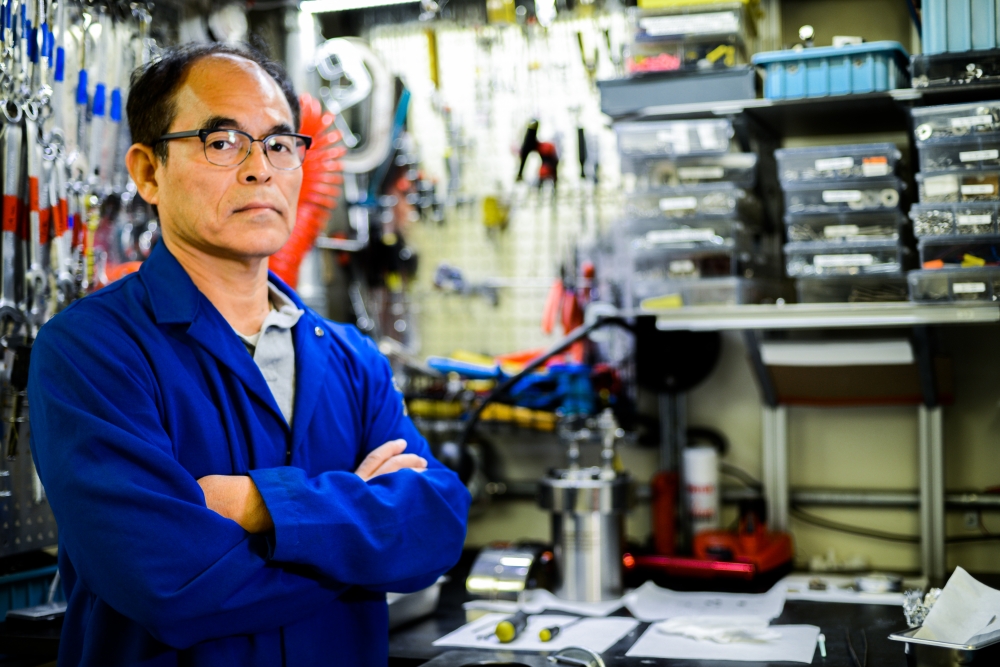
‘For Pioneering Discoveries’
Once in a great while a technology becomes so ubiquitous that it transforms modern life. Such has been the case for LED lighting — efficient, durable, versatile, and now found in everything from flexible displays and cellphone screens to standard indoor, outdoor and automotive lighting.
Making the LED lighting revolution possible is Shuji Nakamura, a professor of materials and of electrical and computer engineering at UC Santa Barbara. His work perfecting the Gallium nitride (GaN)-based bright-blue LED was the missing piece that completed the spectrum, allowing white LEDs to become a reality and replace less efficient light bulbs. That, in turn, greatly reduced power usage and heat generated by lighting applications.
For “pioneering discoveries, synthesis and commercial development of Gallium nitride LEDs and their use in sustainable solid-state light sources, which are reducing global greenhouse gas emissions while also reducing costs to those adopting this technology,” Nakamura has been selected to receive the National Academy of Sciences (NAS) 2020 Award for the Industrial Application of Science. Presented triennially, the award, which this year focuses on sustainability, “recognizes applications in industry of significant achievements in science.”
“I am honored to receive the NAS Award for Industrial Application of Science as it recognizes the huge impact of GaN LEDs and lasers,” said Nakamura, who also co-directs UC Santa Barbara’s Solid State Lighting & Energy Electronics Center. “LED lighting is over 80% energy efficient and saves consumers vast amounts on their electricity costs while reducing greenhouse gas emissions. I’m also excited about emerging applications such as micro-LED displays and laser lighting — which is 100 times brighter than LEDs — and promises automobile headlamps, laser projectors, and a next generation of general illumination sources.”
LEDs have been in practical use since the 1960s. The red LED was invented first, followed by orange, yellow and green LEDs within a decade or so. As the technology behind those LEDs improved, however, blue, with its short wavelength and high frequency, remained beyond the reach of conventional materials and methods for roughly two decades.
Enter Nakamura who, in the 1990s, as a researcher for Nichia Chemical Industries, Ltd. in Japan, began to experiment with GaN. It was a promising but tricky compound, prone to defects. By developing a technique called “two-flow metalorganic chemical vapor deposition,” he made possible the growth of high-quality GaN crystals, which serve as the foundation for bright-blue LEDs. In 2014, Nakamura, who joined the faculty at UC Santa Barbara in 2000, won the Nobel Prize in Physics for the blue LED, along with Hiroshi Amano and Isamu Akasaki of Nagoya University.
“It is always enjoyable to congratulate Shuji Nakamura for the next in an ongoing series of extremely well-deserved honors for his world-changing research, which made widespread LED lighting possible, and that is true now, as he receives the NAS Award for the Industrial Application of Science,” said Rod Alferness, dean of the UCSB College of Engineering. “We are all better off for having Shuji among us, not only for his tremendous contributions to developing effective, energy-efficient GaN-based lighting and power devices, but equally for his value as a supportive, generous and engaging colleague.”
The recipient of numerous awards and honors, Nakamura has also been recognized with the Materials Research Society Award, the Institute of Electrical and Electronics Engineers Jack A. Morton Award, the Millennium Technology Prize, the Prince of Asturias Award for Technical Scientific Research, the Order of Culture Award in Japan, the Global Energy Prize and the Zayed Future Energy Prize. He is a fellow of the National Academy of Engineering and of the National Academy of Inventors and has been inducted into the National Inventors Hall of Fame.
Nakamura continues his work on solid-state lighting with his colleagues at UCSB, improving on the techniques for producing ultraviolet, blue, green, yellow and red LEDs, as well as developing laser-based lighting, vertical-cavity surface-emitting lasers and high-efficiency power electronics.
Nakamura will receive the award, which includes a prize of $25,000, at a ceremony during the NAS annual meeting in April in Washington, D.C.



